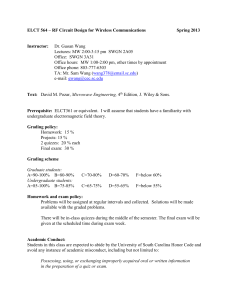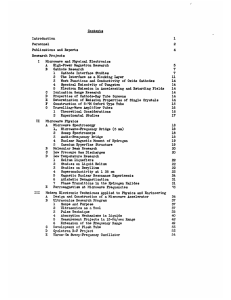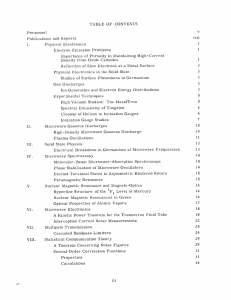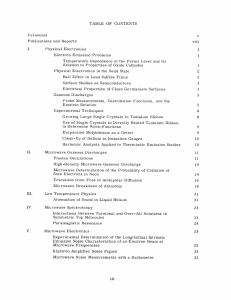Academic and Research Staff
advertisement
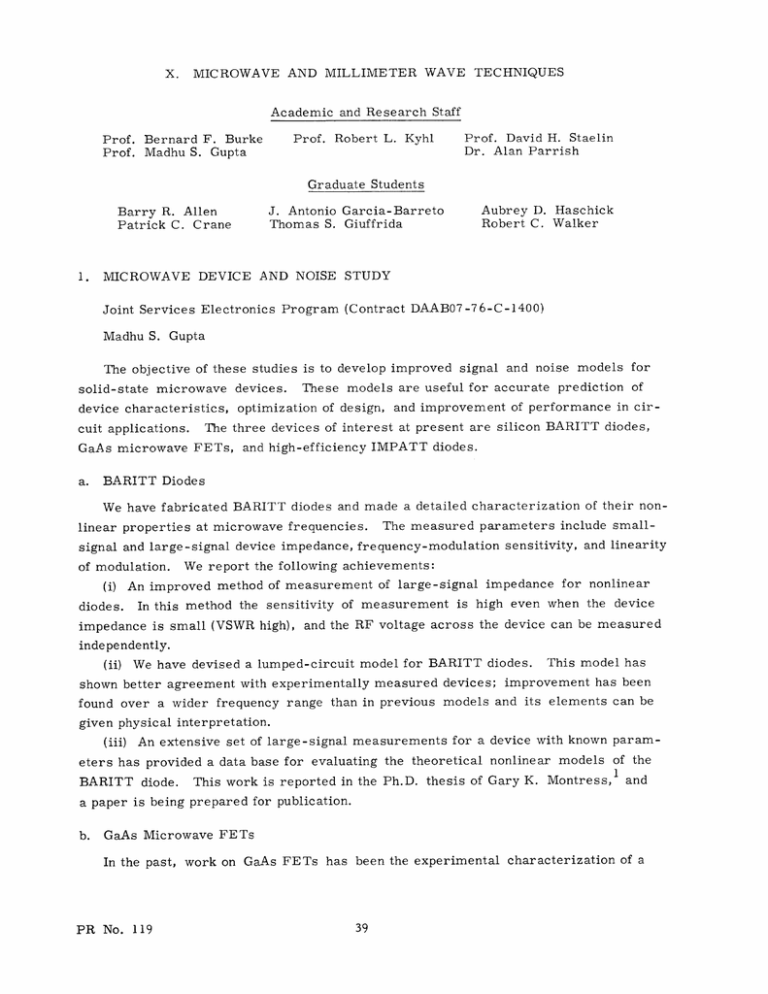
X. MICROWAVE AND MILLIMETER WAVE TECHNIQUES Academic and Research Staff Prof. Bernard F. Burke Prof. Madhu S. Gupta Prof. Robert L. Kyhl Prof. David H. Staelin Dr. Alan Parrish Graduate Students Barry R. Allen Patrick C. Crane 1. J. Antonio Garcia-Barreto Thomas S. Giuffrida Aubrey D. Haschick Robert C. Walker MICROWAVE DEVICE AND NOISE STUDY Joint Services Electronics Program (Contract DAAB07-76-C-1400) Madhu S. Gupta The objective of these studies is to develop improved signal and noise models for solid-state microwave devices. These models are useful for accurate prediction of device characteristics, optimization of design, and improvement of performance in cirThe three devices of interest at present are silicon BARITT diodes, GaAs microwave FETs, and high-efficiency IMPATT diodes. cuit applications. a. BARITT Diodes We have fabricated BARITT diodes and made a detailed characterization of their nonlinear properties at microwave frequencies. The measured parameters include smallsignal and large-signal device impedance, frequency-modulation sensitivity, and linearity of modulation. We report the following achievements: (i) An improved method of measurement of large-signal impedance for nonlinear In this method the sensitivity of measurement is high even when the device impedance is small (VSWR high), and the RF voltage across the device can be measured diodes. independently. We have devised a lumped-circuit model for BARITT diodes. This model has shown better agreement with experimentally measured devices; improvement has been found over a wider frequency range than in previous models and its elements can be given physical interpretation. (iii) An extensive set of large-signal measurements for a device with known param(ii) eters has provided a data base for evaluating the theoretical nonlinear models of the BARITT diode. This work is reported in the Ph.D. thesis of Gary K. Montress,l and a paper is being prepared for publication. b. GaAs Microwave FETs In the past, work on GaAs FETs has been the experimental characterization of a PR No. 119 (X. MICROWAVE AND MILLIMETER WAVE TECHNIQUES) device in order to relate it to its model.2 This model was used to design an optimum low-noise microwave amplifier with the device under low-temperature operating conditions. 3 An attempt has been made to construct this optimized amplifier. 4 Measure- ments on the amplifier have suggested that the biasing of the device can be modified to improve the stability, with a small sacrifice of amplifier performance. c. High-Efficiency IMPATT Diodes Our research on high-efficiency IMPATT diodes is directed toward measuring oscil- lator noise spectra. Quantitative agreement between experimentally measured and the- oretically calculated noise spectra has not been achieved for high-efficiency diodes. IMPATT Recent theoretical analyses5 show that the FM noise measure can be calculated reasonably well if the effect of signal power level upon temperature, upon the reverse saturation current, is accounted for. and of temperature We are attempting to measure both AM and FM noise spectra, as well as the correlation coefficient. These measure- ments will be used for comparison with theoretical results. References 1. G. K. Montress, "Fabrication and Large-Signal Characterization of BARITT Diodes," Ph.D. Thesis, Department of Electrical Engineering and Computer Science, M. I. T., October 1976. 2. J. F. Cooper and M. S. Gupta, "Microwave Characterization of GaAs FETs and the Verification of Device Model" (to appear in IEEE J. Solid-State Circuits). 3. J. F. Cooper, "Characterization of a Microwave GaAs FET at Low Temperature," S.B. and S.M. Thesis, Department of Electrical Engineering and Computer Science, M. I. T. , June 1976. 4. J. C. Carrick, "Construction and Measurement of High-Frequency Amplifier with GaAs FETs," S.B. Thesis, Department of Electrical Engineering and Computer Science, M. I. T. , August 1976. 5. H. Statz, R. A. Pucel, J. E. Simpson, and H. A. Haus, "Noise in Gallium Arsenide Avalanche Read Diodes," IEEE Trans. on Electron Devices, Vol. ED-23, No. 9, pp. 1075-1085, September 1976. 2. ATMOSPHERIC REFRACTION AT MILLIMETER WAVELENGTHS Joint Services Electronics Program (Contract DAAB07-76-C-1400) Bernard F. Burke, Alan Parrish, Thomas S. Giuffrida, Barry R. Allen The microwave aperture synthesis interferometer (described in Section XIII-6 and in previous RLE Progress Reports) will be used to study refraction and absorption in the Earth's atmosphere. The initial measurements will be made at 13 mm. In January we shall begin to make measurements at high and low angles of elevation, under a variety of weather conditions. The system will be converted to operation at 7 mm 1977, PR No. 119 (X. MICROWAVE AND MILLIMETER WAVE TECHNIQUES) during 1977. Interference fringes have been detected at 13 mm by the entire digital system. The 150-MHz correlator works well, and the measurement phase of the project awaits only the interfacing of the digital delay system with the computer, 3-element correlator and phase reference controls. PR No. 119 and the completion of the
